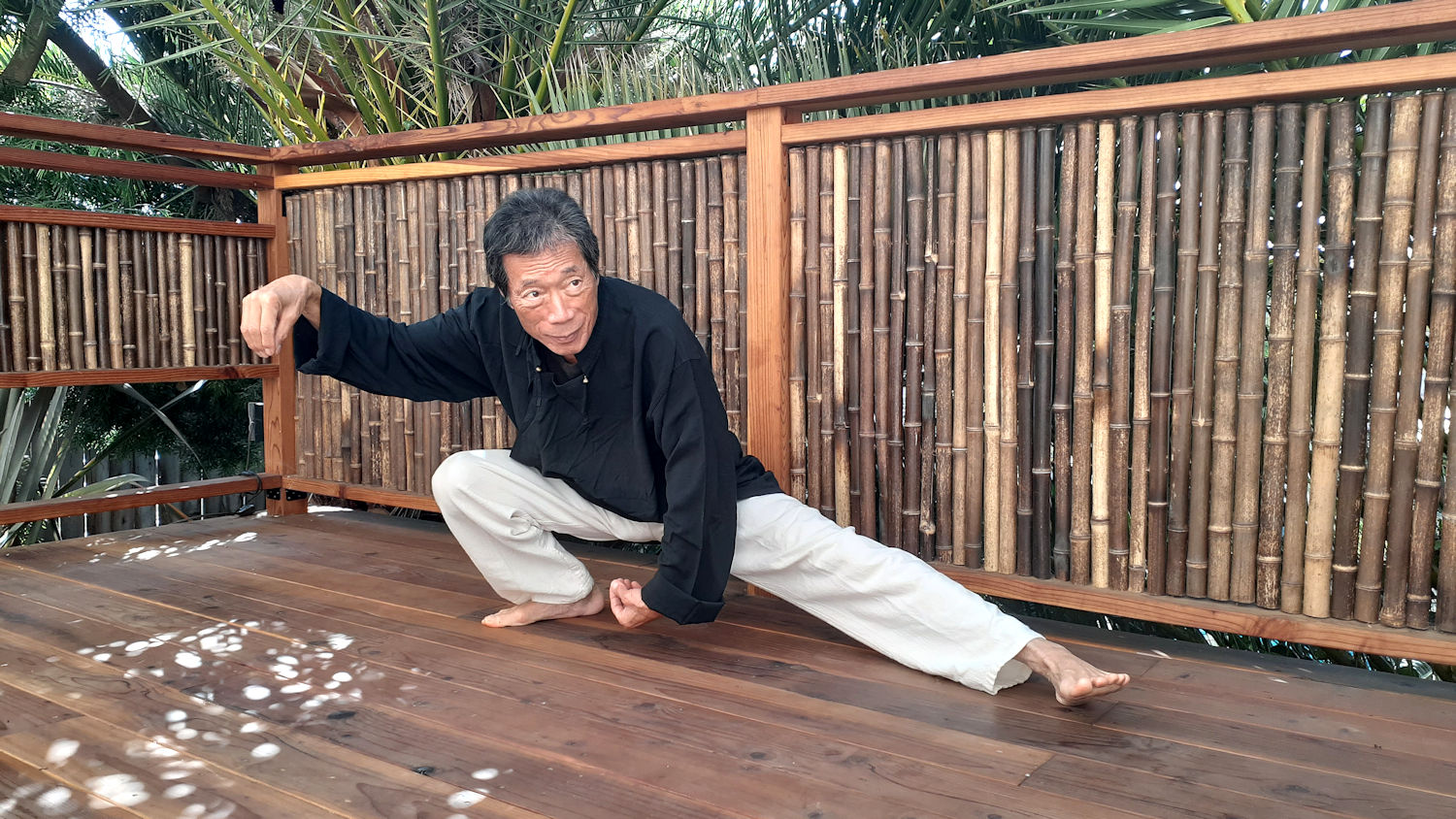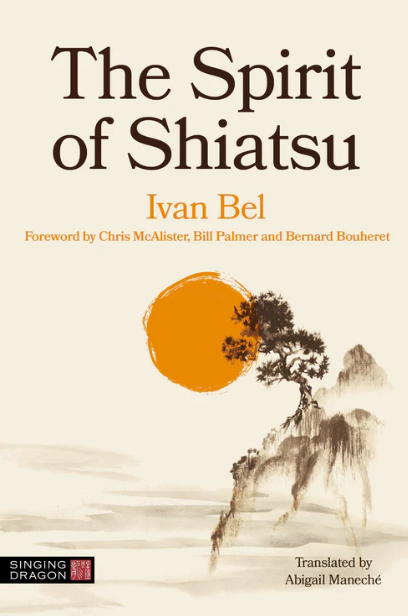Among the great contemporary figures of Shiatsu, Tsuneo Kaneko sensei is one of the great promoters of Shiatsu and Anma, of which he is a graduate, and holds the title of Doctor of Oriental Medicine. Trained by the greatest masters, including Dr. Katsusuke Serizawa, he has been practicing and teaching these two techniques for 50 years in California (USA) and before that in Japan. His first teachers were his parents because these techniques are above all a family tradition. With the numerous exchanges we had, I was able to discover a person of great philosophical and spiritual depth, aspects that I asked him to develop in this interview. This interview is therefore not only a life story, but a true sharing of a life dedicated to care of his fellow humans being.
Ivan Bel: Hello sensei. First of all, I would like to thank you for accepting to do this interview. I hope that all is well with you and your family in California, during this Covid epidemic.To begin with, could you tell me a little about your background ? Where were you born?
DoAnn T. Kaneko: I was born in the very modern metropolitan city of Tokyo.
What kind of childhood did you have in Japan at that time?
I was born right after the second world war, in 1947. Many of us in Tokyo lost homes and lived in poverty. We were baby-boomers that had to face a hard journey through higher education, jobs, and marriage?! We had tough competition to be on the winning side. Japan had a miraculous recovery and succeeded in rebuilding their families and the economy because everyone tried so hard to be prosperous and happy.
My father was very conservative and had severe discipline while my mother was sweet and gentle to us. I grew up in a home where other Anma apprentices lived with us.
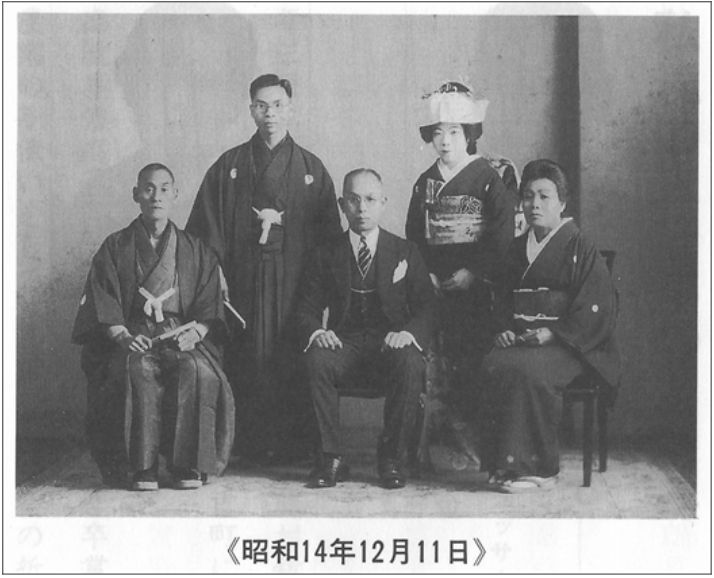
It seems that you are the second generation of a family of Anma practitioners. Does this mean that your parents were already doing this profession?
My father practiced both acupuncture and Anma massage and my mother practiced Anma massage. Both my parents had a limited education in their childhood because of the poverty in the countryside. They met as apprentices at their teacher’s home, working and living together with other students. Their teacher took care of them and they later started a business that grew well.
After my parents married, Japan lost the war, and my father came home safely after the war. My parents worked hard and succeeded quickly in restarting the Anma and Acupuncture clinic they had lost during the war. It was an amazing achievement and they extended the business when my brother and I were in junior-high school. My parents gave me and my brother a loving and excellent education.
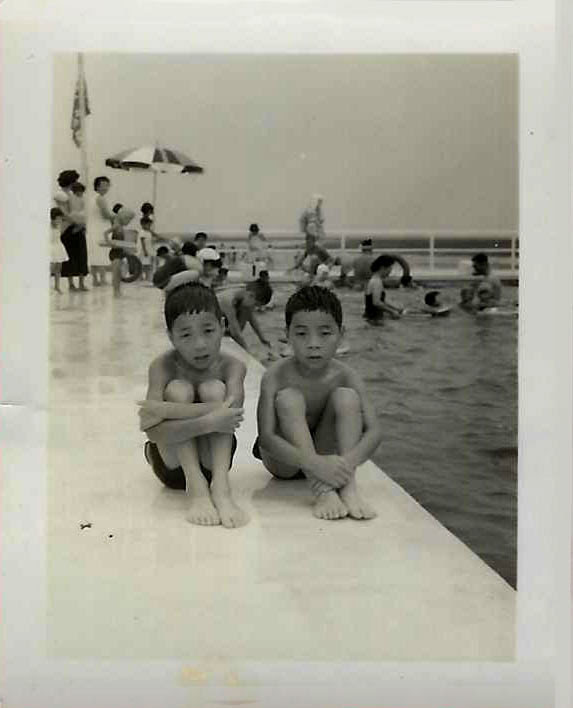
And yourself, at what age did you start to take an interest in manual therapy ?
I never liked my parent’s profession because it was a very old, antiquated business and nothing modern. I liked the western culture, often watched TV and used to listen to popular music stations on the radio. These programs from the US gave me a happy feeling. I was very open, naive and americanized.
My parents and I maybe expected that I would be more successful in another field. I eventually majored in economy and I gained a bachelor’s degree in it at Rikkio University, one of 6 major Ivy league universities.
But during college at one point I needed some income to go on a trip during the summer vacation. I got a part-time job from my parents’ work when I was about 19 years old. They trained me on how to practice a one-hour Anma form treatment. All I needed to learn was mastering the sequence and how to make my clients feel better based on my instinct without knowing the advanced theoretical background, which was a very effective way to learn healing. I appreciate it now. It is called Taitoku (体得) in Japanese and means to stop questioning and to learn through experience, like just learning swimming without a textbook.
What is the origin of the family Anma style you were practicing?
My parents studied Anma through their master Koichian Inoue ( こういち庵) who taught Sugiyama-ryu Anma along with acupuncture practice. Waichi Sugiyama [1] was a very successful, famous blind acupuncturist who published books and opened a school. He invented a Japanese-style needle- guiding tube, which makes the insertion of the needle painless and easier. His Anma teachings were continued over 400 years but his particular style may have disintegrated now as there are no more schools teaching it today.
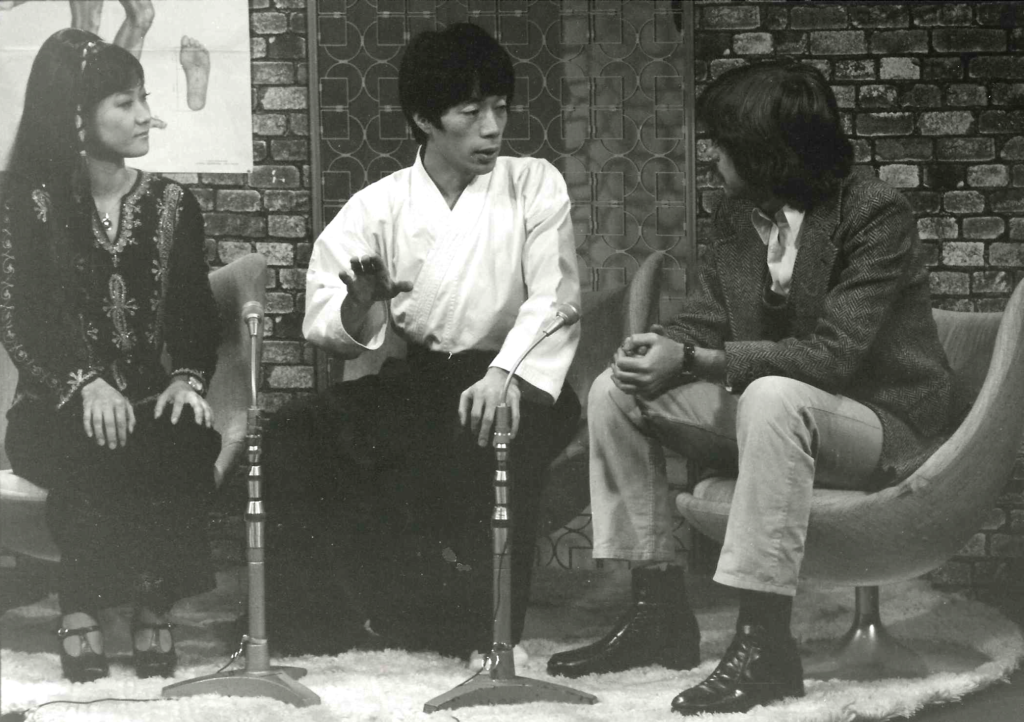
My father did not teach me other styles but I remember he mentioned Yoshida-Ryu[2] and he said that it uses strong elbow techniques and that it is sometimes very painful. When we knead the body tissues hard, this action sometimes forms extra tissue called Momidako (もみだこ ). It is some extra tissue (fibre, fascia) due to over stimulation. This is one of the reasons why Anma was denounced by Shiatsu specialists because Anma applies lots of these kneading techniques, more than pressure techniques. I pay very careful attention when I teach and use these cross-fiber and rotating-fiber kneading techniques.
You decided to study at Toyo Acupuncture College (Toyo Shinkyu Senmon Gakko) [3] and SAMRA – University of Oriental Medicine[4] near Los Angeles. What subjects did you study?
First, I majored in a 3 year full time course at Toyo Shinkyu Senmon Gakko which included Anma massage, western massage, shiatsu, acupuncture and moxibustion. Their curriculum had more western medicine, anatomy, physiology, symptomatology, pathology, Western treatment, then Kanpo (Traditional Japanese Medicine) TCM, techniques, and traditional meridian therapy. It is extremely important to understand the western point of view on sickness and health. We need to present ourselves to our patients and students as highly educated therapists in both western and eastern medicine. Additionally, I attended an internship with Dr. Nobuyasu Ishino, an obstetrician, to learn Japanese-style herbs. This is one of the best training methods and helped me to prepare for and to pass the national examination and to receive my license in Japan.
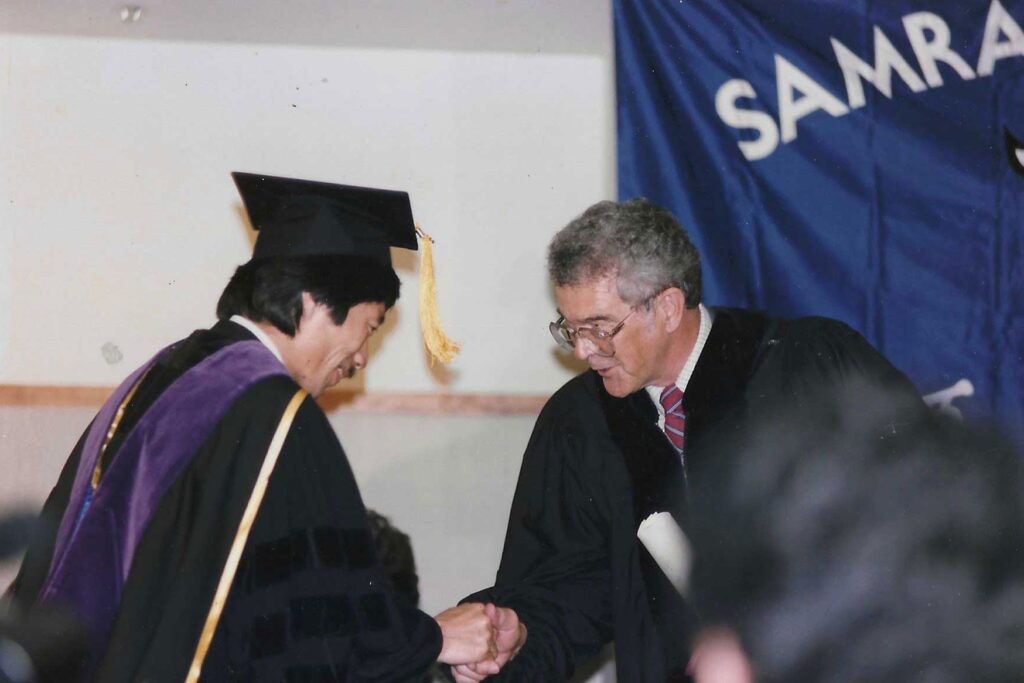
Secondly, I took a course for my Ph.D. in oriental medicine and received my O.M.D (Oriental Medical Doctor) in Samra University of Health Sciences, in 1983-1984. I learned about auricular acupuncture, electro-acupuncture, therapeutic exercises, Chinese herbal principles and clinical applications for alcoholism and drug addiction, dermatology, gynecology, etc. My dissertation was about the “9 kinds of needles“ introduced in Zhen Jiu Da Cheng (Compendium of Acupuncture and Moxibustion.) This application of 9 kinds of needles helped me to understand how important it is to take care of both the skin surface and the tissues below the skin in Anma Therapy.
Those schools are famous, especially Toyo Shinkyu Gakko. Its founder was Sorei Yanagiya, I believe ? Did you meet him?
Grand Master Sorei Yanagiya (柳谷 素霊 – 1906-1959) was the founder of Toyo Shinkyu Senmon Gakko but he was not alive when I enrolled. His wife was the chairman at the time and I met her. I was inspired to introduce Anma to the US as he had done in Europe. There is a famous story that he treated Pablo Picasso while on his trip to lecture about the science of acupuncture. I learnt his teachings through his successful disciples who were teaching in the school. One of them was Hashimoto Sensei, who privately taught me Ota’s Anpuku as Master Yanagiya sensei introduced it in his Anma textbook.
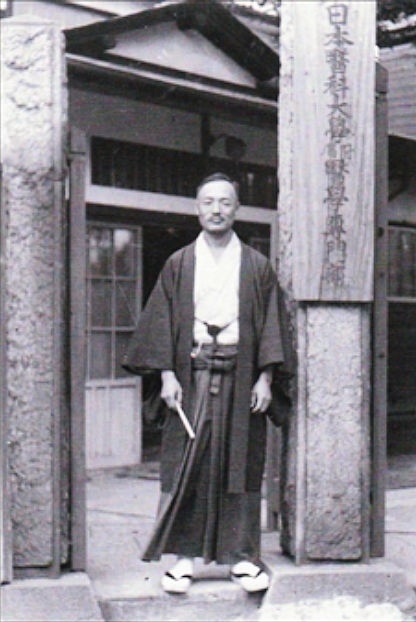
What are your memories of this period as a student? Was it difficult?
It was a fascinating period in Japan with my wife. I kept working for my parents, taking care of our newborn baby, Lisa, in addition to studying hard in school full- time. I did very well in every path and it was miraculous. I achieved a lot as I knew that I would return to the US to introduce Anma, Shiatsu, and other healing arts. I was also very interested in Western Science. It is extremely important for me to integrate eastern and western medicine and I wanted to be able to explain the classic terms of eastern medicine in the western terms. Three years was not enough but I wanted to absorb the most out of my stay in Japan. I was always hungry to learn more. I continued going to school in the US and gained my Ph.D Degree at Samra University as I mentioned before.
I returned to NY a few years later after I completed the 3 years course but I couldn’t use acupuncture there, so I went back to California in 1980 and there I could use all my techniques. Two years later I opened my school the Shiatsu massage school of California.
The Anma and Shiatsu of your school are largely influenced by the great teacher Dr Katsusuke Serizawa [5]. How would you define his influence on these techniques? Did you meet Serizawa sensei?
I met Dr Serizawa in his office and shared my ambition to introduce Shiatsu and Anma to the western world. I was very deeply influenced by his scientific research about Anma massage, Shiatsu, acupuncture and moxibustion. His definition of Anma and Shiatsu was standardized through an official textbook. It was very important information to pass the national examination according to this officially authorized definition. He published the book, “TSUBO” in English. He was very clear about the application of traditional Chinese medicine of Yin and Yang, Anma and Shiatsu, acupuncture and moxibustion.
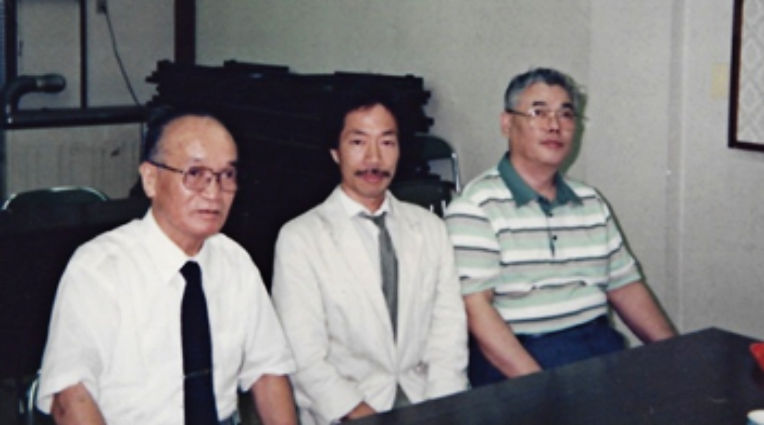
Also, in this school, you had to learn Western massage. In your opinion, does it bring a plus compared to Anma and Shiatsu?
Again, I love to learn western medicine and western medical massage, like the lymphatic massage technique, that is different from ours. When I understood the difference I was empowered and felt strength in understanding, assessment and in healing. I found there was no conflict, as I value western medicine and feel it complemented eastern medicine.
Finally, could you tell me who were your main teachers of acupuncture, Anma and Shiatsu?
My parents were my first teachers. I appreciate what they taught me and am grateful that I could carry on the family tradition. Master Yanagiya Sorei wasn’t there anymore when I was studying his teachings but his disciples were there, teaching in his school.
Then there was Nobuyasu Ishino (the dean of Toyo Shinkyu Senmon Gakko), who was a gynecologist and obstetrician in his Koundo clinic in Tokyo. I internshipped with him and learned a very sensitive and delicate needling method, treating the skin on a surface level and I observed his clinical herbal application. Other teachers were Sato Sensei who taught Shiatsu therapy based on Dr. Serizawa’s methods and Hashimoto sensei who shared Shinsai Ota’s anpuku techniques.
Historically, what are the main differences in the conception of Anma and Shiatsu? You say that Shiatsu is a modern science and Anma an ancient science. Can you elaborate?
The history of Shiatsu has not been correctly introduced in the western world and my mission is to educate the Shiatsu communities with respect and reveal the truth about Anma and Shiatsu based on Dr. Serizawa’s definition. His teachings were the only ones that were recognised and authorized as a standard, throughout the oriental medical educational programs, at the time when I was a student.
According to his definition and his scope of practice, Shiatsu was formed basically and partially based on the principle and practice of classical Anma therapy that was imported from China around 701 (the Japanese government established a medical system and set up a health department in the title of Doctor degree of Anma).
Shiatsu was practiced before the 20th century along with Anma therapy, Doin therapy (Daoyin in Chinese) and the Kappo method of Judo practice (the resuscitation and the reviving of Judokas who had accidentally fainted or been injured during judo practice). But after the middle of the Meiji period (1900), chiropractic, osteopathy and spondylotherapy were imported from the US to Japan and influenced traditional Anma-Doin therapy. They also produced various manual therapies including Shiatsu therapy.
Dr. Serizawa did not mention the name of the founders in each style but it seems there were unknown founders of shiatsu before Tamai Tenpeki. But Dr. Serizawa acknowledged Master Namikoshi’s style with modern terms without either Anma and TCM elements. Master Namikoshi gained popularity because he introduced western medical ideas and applications in his shiatsu style.
Before I became interested in my parent’s profession of Anma and acupuncture, I felt that it was so old and I did not realise its scientific effectiveness. Japanese folk people were interested in the latest western science and modernism and I was not an exception to this as we learned science in school.
That’s how Namikoshi sensei answered the public’s unspoken demands by adding science in a new technique. People paid more attention and were attracted to modern Shiatsu instead of old Anma. Master Namikoshi sensei and his son Toru sensei made a wonderful contribution to make Shiatsu very popular in the world. They set up a short course that was additional to their 2 years regular license course for Japanese laymen. They also taught a two month program. I was told that some foreigners attended their school in Tokyo and that these students introduced Shiatsu into their own countries. Ohashi sensei was one of the most talented Shiatsu masters who took this course.
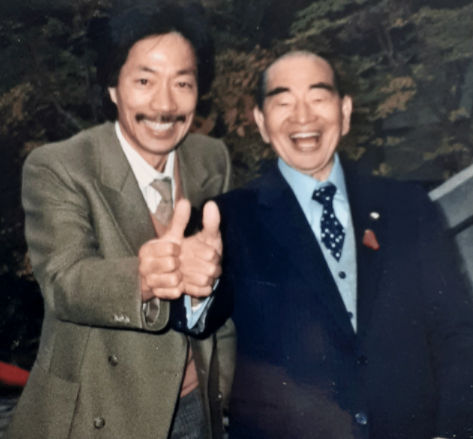
Grand master Namikoshi’s son, Toru Namikoshi sensei, spent 7 years in the US, introducing Shiatsu to students at the Palmer School of Chiropractic in Davenport (Iowa) according to the Handbook of Healing Sage Techniques. This is the exact example of how scientific Shiatsu has been introduced to the world without the notion of classic Anma massage therapy.
Technically does this mean that there are some differences? For example, could you tell me what the differences are between Shiatsu pressure and Anma pressure?
I respect Dr. Serizawa’s teachings, in his many publications and I practice Anma through my long form of shiatsu and through my short form. According to Dr.Serizawa’s definition, Anma was developed along with acupuncture and moxibustion in China. Anma therapy was mentioned in the Yellow Emperor’s classic book. Anma means press and sedate excess energy (to reduce inflammation, like acupuncture needles). Ma means to soothe and tonify (like Moxibustion which improves the circulation.) So, Anma was used to bring balance by applying either pressing or soothing while prescribing proper vital points of each meridian, and 5 element points. Also when you press the pressure point, the indication of each pressure point should be realized.
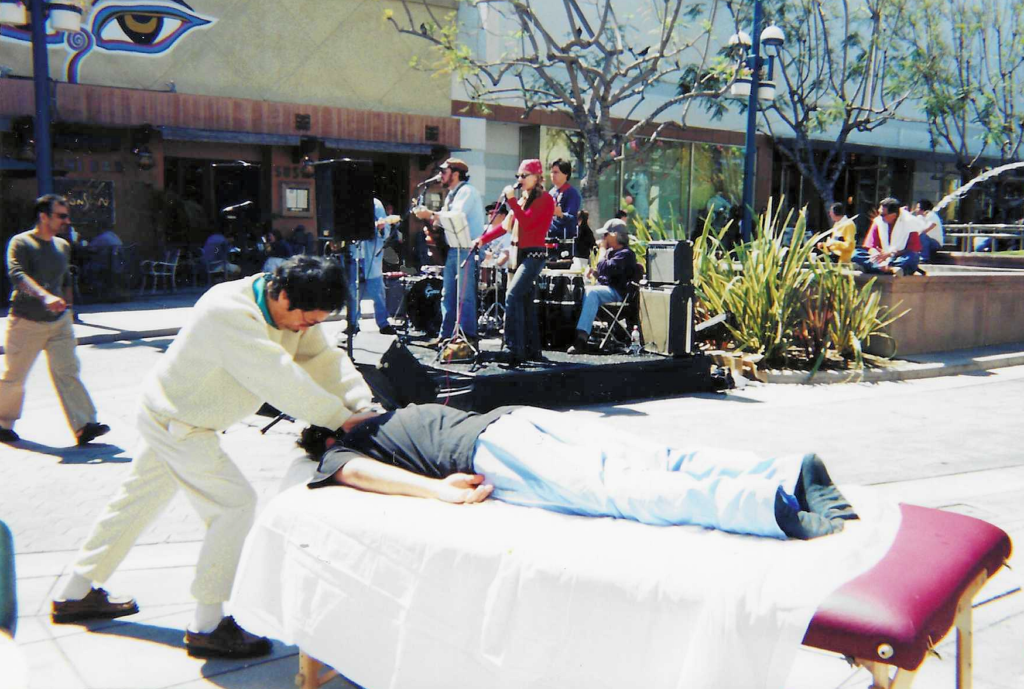
The weight of pressure techniques in Anma is limited since it focuses on soothing, kneading, tapping, vibrating, shaking, snapping, joint mobilization, and stretching. While according to Dr. Serizawa, Shiatsu has many sophisticated pressure techniques. Dr. Serizawa listed 7 Shiatsu pressure techniques.
- Ordinary pressure that is applied for 5-7 seconds
- Quick pressure, 2-3 seconds. I call it intermittent pressure
- Pressure is also applied by increasing 2 step pressure. Also you can increase it using 3 step pressure.
- Continual pressure with palms for a minute or so
- Suction technique with palms or 4 fingers to cup the skin
- Pressing with vibrating techniques
- Non-chiropractic forceful adjustment, but shallow thrusting technique (along the spine)
Anma only uses a limited simple pressure technique but shiatsu has many. The manipulation technique of Shiatsu was based on Kappo of Judo ( Reviving and resuscitation technique among Judo practice) and the classic Doin method.
We Western shiatsushi have little knowledge of the history of Shiatsu, and even less of the history of Anma. The main reason for this is that many Japanese books have not yet been translated. I suppose that this history goes back long before the founder of Shiatsu, Tenpeki Tamai?
As is the case in many fields of Japanese culture, Shiatsu overshadowed Anma in popularity because of the inclusion of modern western medical concepts. Anma therapy at one point was the most authentic classical massage therapy from TCM. Unfortunately, those who did not learn or realize the importance of athletic Anma therapy spread more modern Shiatsu therapy alone instead, which was liked by Namikoshi Sensei. Now, Masunaga sensei introduced someTCM and Master Ohashi supported these masters from Japan. This is how major Shiatsu styles have been rooted in the USA. Anma did not have much chance of being introduced alongside Shiatsu, due to the lack of interest and /or a lack of knowledge and publications in English. Tamai Sensei and Namikoshi sensei’s Shiatsu styles have strong western modern anatomical and physiological backgrounds and put less value on authentic TCM.
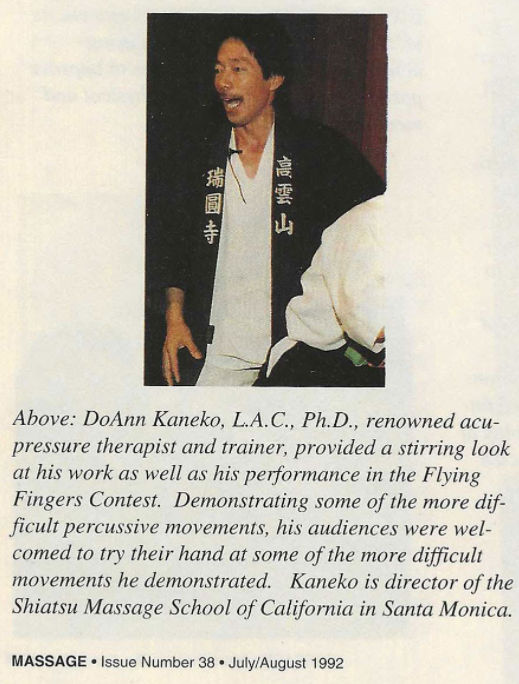
It is important to note that in the 50’s and 60’s, there was a dispute between Anma and Shiatsu. Shiatsu had a more modern scientific vision and Classical Anma’s authentic value was being lost. Many Anma therapists did not value the kanpo (漢方) thus Anma lost its eastern medical value and became more commercial.
But Shiatsu therapists wanted to appeal to the therapeutic value of pressure techniques and application.
There was an interesting report that tapping techniques of Anma causes accelerated heart beats (sympathetic nervous system) and was not good for heart conditions.On the contrary, the pressure technique effectively regulates the parasympathetic nervous system and calms down the heart rhythm.
Interesting. If I’m right, you are one of the very first Shiatsu practitioners in the USA. Who were the other Japanese teachers who introduced Shiatsu to the North American public?
TheTappan’s Handbook of Healing Massage Techniques book by Patricia J. Benjamin and Frances M. Tappan (4th Edition; pg 315) states that several systems of Asian bodywork therapy were introduced in the west in the 1970s by people like DoAnn T. Kaneko (Santa Monica), Shizuto Masunaga (Tokyo), Shizuko Yamamoto (Boston), Toshiko Phipps (Teacher of School in Vermont, involved in RBTA), and Takashi Nakamura (kabuki spa, in San Francisco, Anma kata), after Tokujiro Namikoshi (Tokyo) and Toru Namikoshi (Palmer School of Chiropractic in Davenport, Iowa 1950s-1960 ). On page 340, it mentioned that during the 1970s, a number of other practitioners brought their styles of shiatsu to the United States, including DoAnn Kaneko, who brought a form called Anma Shiatsu, Shizuto Masunaga, who developed Zen Shiatsu, Shizuko Yamamoto, who developed Barefoot Shiatsu and Wataru Ohashi who developed Ohashiatsu. In 1977 Takashi Nakamura Sensei first formally introduced traditional Anma at his school in San-Francisco, the Kabuki Shiatsu School of Massage.
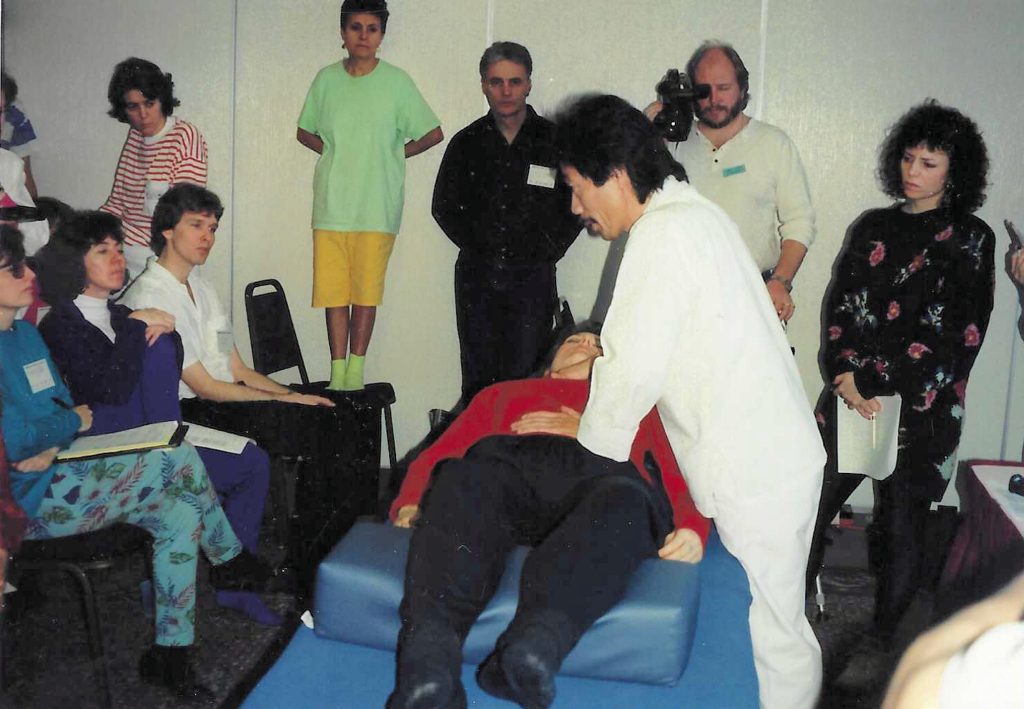
Thank you for those clear details. So eventually you decided to create your own style and call it simply Shiatsu-Anma. I imagine that it must not have been easy to establish this type of therapy in the beginning.
Not at all. Not many Shiatsu therapists knew about Anma and it was the reality in the US. I accepted it, and yet I was excited to introduce Anma through my Long Form, a 60 minute Kata Form sequence with 3 postures and about 130 vital points in the major meridians. I also distinguish it from Shiatsu in my 30 minutes Short Form with only pressure, correcting-stretching exercises and a joint mobilization technique.
After how many years did you start teaching and then open your clinic, the Tao Healing Arts Center in Santa Monica?
It was about 1970 when my parents taught me the Anma kata. During my studying period in Tokyo from 1976 till 1979, I started teaching Anma & Shiatsu under the IDO (医道) Center (The way of healing) for foreigners in Tokyo. At the time most of them were English teachers. I returned to New York in 1979 and opened the Tao Healing Arts Center there. Then I moved to Santa Monica, California, and opened the non-profit organization Shiatsu Massage School of California along with the Tao Healing Arts Center in 1982.
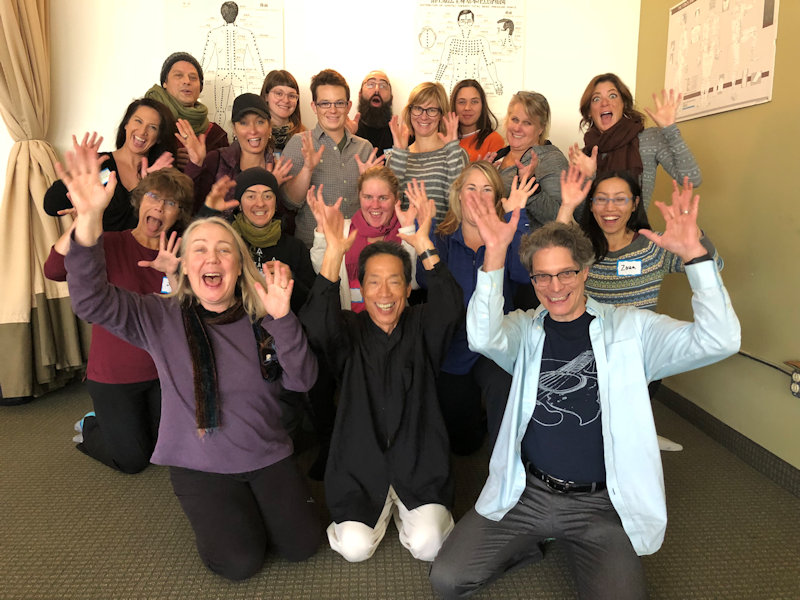
I believe you are one of the founders of the US Shiatsu Federation. How did that happen? What role did you play and with whom?
Let me quote for you this extract from the American Oriental Bodywork Therapy Association Interim Bulletin, winter 1990
“The association was officially incorporated in 1990.
On the weekend of August 26 and 27, 1989, leaders of the major American associations and schools of Oriental Bodywork Therapies met in Kerhonset, New York and agreed to form the American Oriental Bodywork Therapy Association (AOBTA). The focus was aimed at bringing together American practitioners of many Oriental Bodywork Therapies and developing high educational standards on a national level. Group representatives agreed to join their Associations together in order to form a new, unified national organization able to represent and speak for all practitioners of Oriental Bodywork Therapies. At the time the major groups which agreed to unite were:
- The American Shiatsu Association (ASA)
- The Midwest Shiatsu Association (MSA)
- The Shiatsu/Anma Practitioners’ Association (SPA)
- The Jin Shin Do® Foundation”
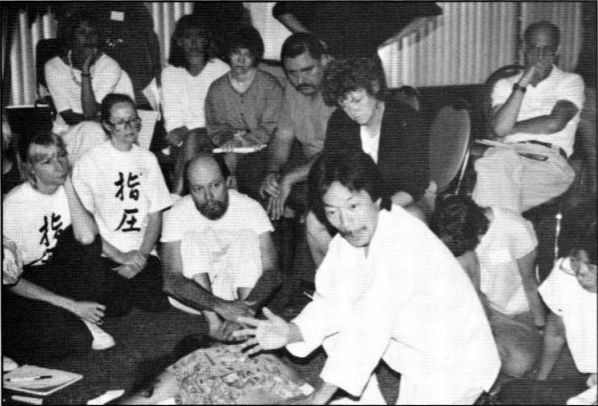
Nandi (Carl) Dubitsky, Director of Education, was one of 3 of my students who committed to learning more about Anma. He published his book on Anma before my book but shockingly passed away before me and it was a big loss. When forming the AOBTA, I remember AOBTA President Steven Schenkman and Cindy Banker were meeting often. I had already founded the association SPA, mentioned previously, and we all brought our students and therapists to the first AOBTA conventions. The first of one was in New Orleans, the second one was in Arizona. But at the time I was running my school and clinic, in addition to my heavy clinical work, 6 days a week, 7-8 patients per day, so I couldn’t join their Board. Additionally I was in a Ph.D. and O.M.D program at Samra University for Oriental Medicine.
In your career, you have done a lot of services, especially to the city of Santa Monica, helping with everyone’s health. But you also did something a bit crazy: following Bob Wieland[6] in his crossing of the USA in a wheelchair. Tell us about this adventure!
One of my most talented graduates, Geary Whiting, was deeply involved in Bob’s campaign and I had an opportunity to assist him only towards the end of his cross country journey in his wheelchair. It was an amazing thing to witness. Bob sometimes used his arms only, no wheelchair. He carried his body through his arms and fists directly on the ground. We worked on his arms and hands with another graduate Lissa Hakim. It was an unforgettable experience.
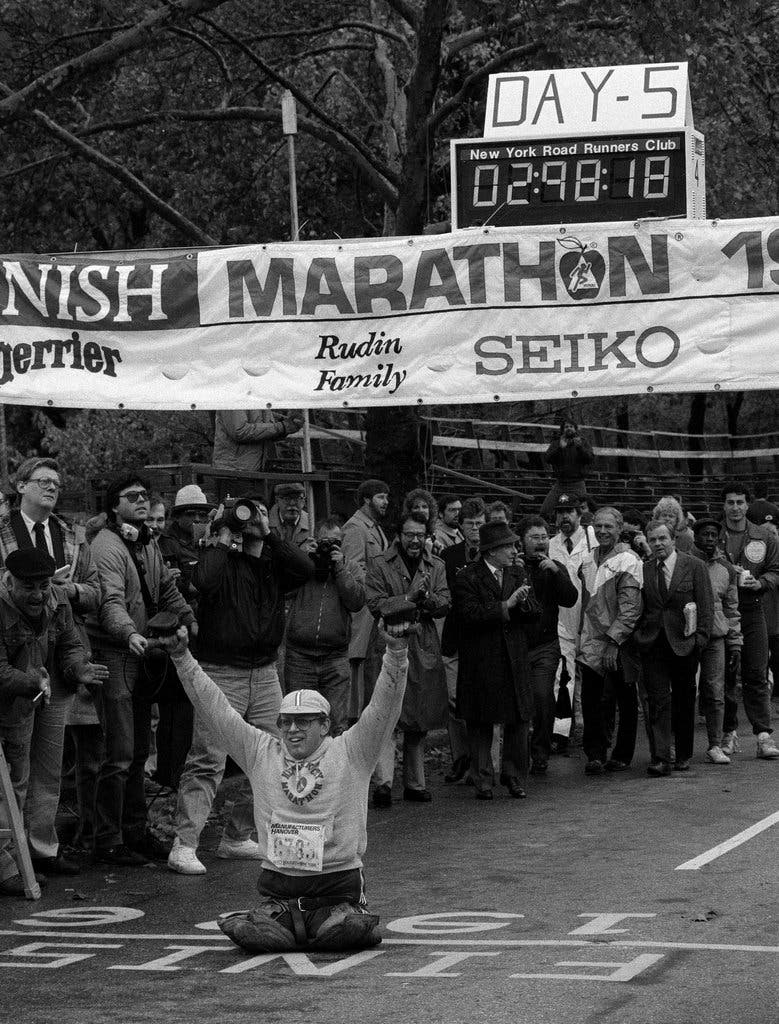
Since your beginning you have given numerous lectures all over the world, seminars and trained hundreds of students. With your experience of almost 50 years, what is your view of the current Shiatsu in the USA?
I have great hope in AOBTA They kept up a high quality of Asian bodywork standards, and sustained their membership. The mainstream of Shiatsu and Anma has been guided by AOBTA as a result of more than 30 years of cooperating work by committed members for an extended time. I respect every major members who have a great dedication to regulate and promote Asian energetic medicine among the general public as well as educate other members. I have great hope in seeing the high quality and standard of Asian bodywork maintained through AOBTA when many varieties of Shiatsu have been created. In the early age of AOBTA, Shiatsu and Anma had limited information. Now, history is being revealed and more therapists are following the concept of integrating these healing modalities like in Chinese medicine. For example, Qigong, Daoyin, and Liandan [7] have been practiced among Anma therapy in combination with Taoist medicine in China. These modalities are within the scope of Acupuncture practice. Now Shiatsu communities are like acupuncture communities in the USA. Asian ancient healing modalities are being revived and Asian body work like Shiatsu and Anma therapists includes these modalities. It is a very exciting era in the Massage and bodywork industries.
All the previous AOBTA presidents were great. Debora Smith and Cindy Banker are amazing Shiatsu therapists who have resilient determination in Shiatsu education. I respect them and I admire their commitment through decades of volunteering work.
During all these years, you have not only taught, you have also studied and practiced a lot. In particular Qigong and Taoism.
Healing is not the art of fixing the symptoms by such techniques as Anma, Shiatsu, and acupuncture. To learn the essence, one has to learn their culture and philosophy where you can often find spiritual elements.
I feel very empowered, cleansed, loved, protected and supported by my disciplined and spiritual daily practices. It gives me unlimited life force. It is basically Buddhist medicine but complemented by Taoism and integrated with quantum medicine. I want to help other healers and share my 9 Mindsets to enhance their spiritual practices. Both medicines inspired me to realize the concept for the 7 Golden Gates. It is like modern jazz masters, modern ballet dancers and painters who often learned from the classics first. In Japanese we say Onko Shishin (温故知新). I was very fortunate to have this traditional Anma from my parents. Anma has a deep Taoist background and I added a spiritual Buddhist healing essence. I want to say that you don’t have to be Buddhist nor Taoist to practice Anma & Shiatsu.
It was ironic that I came to the USA to experience American culture but came to realize the value of eastern and Japanese culture. I am reminded of a Japanese saying. Todai Moto Kurashi (灯台下暗し 暮らし) which means living under darkness or blindness in the foot of the lighthouse. I encountered wonderful spiritual healing programs during my time in New York, like Dr. Mishura ‘s teaching at Ananda Ashram, Eido Roshi’s Zen teaching, Michio Kushi’s Macrobiotic teaching, Da Liu ‘s Tai Chi Ch’uan teaching, Ohashi sensei’s Shiatsu, and Japanese Urasenke Tea ceremony in the U.N. Building. And I value these spiritual backgrounds that give me the depth of the arts and I feel stronger faith.
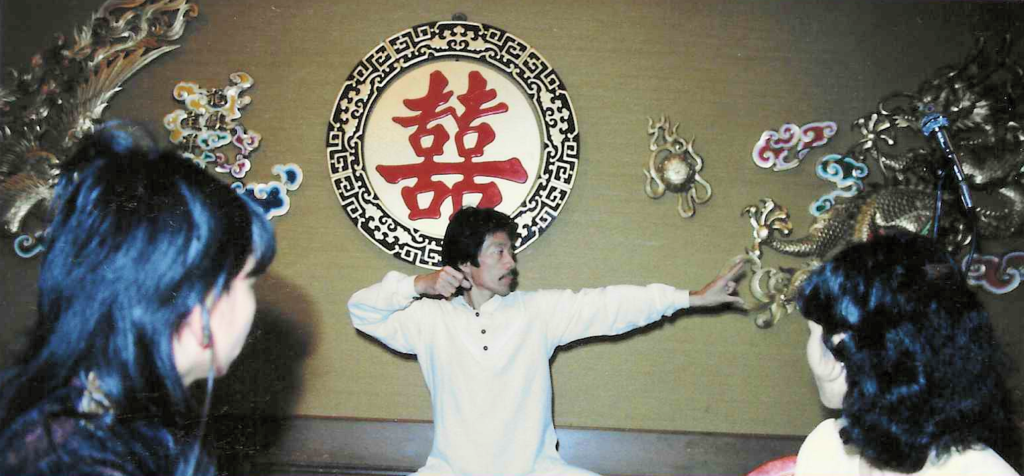
One of the things you are keen to do is to share with Western medicine what the true essence of healing is. You talk about embracing the Seven Golden Gates and engaging in Tenshoku. I am not familiar with these concepts. Would you be so kind as to explain them to me?
I believe the healing we experience is a part of the miracles that the universe manifests. So, we need to acknowledge, appreciate and embrace these miracles of the universe. It is the energy and power of the cosmic consciousness. In my healing paradigm, I share 7 precious healing miracles that the universe manifests. These truths of the universe are out there and simultaneously within our cosmic consciousness as well.
- Power of the Universe
- Power of Wisdom
- Power of Compassion
- Power of Transformation / Change ( metabolism)
- Power of Consistency / Continuity( homeostasis )
- Power of Balance
- Power of Spirituality: Cosmic Consciousness
I learned and recognized what Taoism and Buddhism taught me. First, the Power of the Tenshoku (天職 ) means “The work that was assigned by God or Heaven”. My parents passed on to me this divine healing profession and I am grateful to continue working for people who need help and educating the general public all about healing and happiness.
Integration is one of the most important concepts and my healing paradigm is the crystallization of Taoism, Buddhist medicine, ayurvedic medicine, and quantum healing. The true essence of healing happens when we succeed in integrating body, mind, and spirit. Sickness happens when we have a disintegrated body, mind and spirit.
In recent years you have spoken a lot about the notion of unconditional happiness through what you call the nine states of mind. Can you explain what you mean please ?
Our goal in the healing arts is to help and guide people to feel happy. But often this kind of happiness is relative to certain conditions. People say “If I have this and that, I will be happy“. It’s a mistake. I want to guide people to realize unconditional happiness, even when they are sick they can still be happy and be able to smile at other people. I want to help them to awaken from fundamental darkness and live their life full of compassion, wisdom, and vital force, guiding others to happiness too. In Buddhism one can be enlightened at any second and in any place when one realizes the truth. I want to encourage people to foster wisdom, compassion and their vital force of Qi to realize unconditional happiness. For this reason, I set up these 9 mindsets. Talking about enlightenment, you serve your people and make them happy in Africa, you are enlightened. These are the 9 mindsets :
- Appreciating mind 感謝祈り心 (kansha-shin)
- Breathing mind (for oneness with the Universe), 呼吸心 (kokyushin)
- Caring Mind, 慈悲心 (jihi-shin)
- Peaceful Mind, 平常心 (heijyo-shin)
- Pure Mind, 清浄心(shoujyo-shin)
- Smiling & Shining Mind 微笑み光心 (hohoemi gokoro)
- Enduring Mind,忍耐心 (nintai-shin)
- Respecting Mind, 尊敬心 (sonkei kokoro)
- Unconditional Happiness Mind, 絶対幸福心 (zettai kofuku-shi )
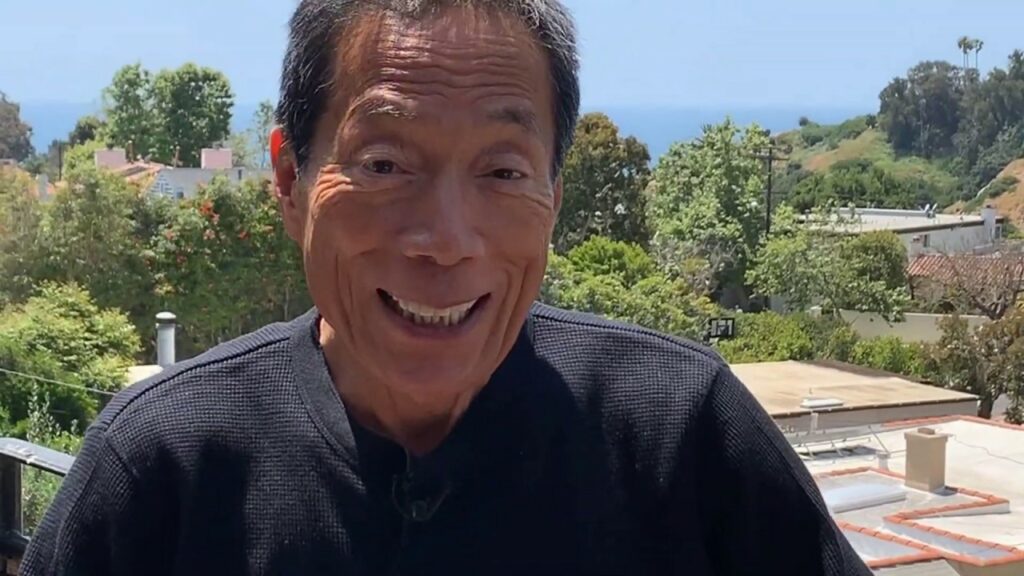
Wow, I can see now that I’m still not enlightened, but thank you (laughs). It is clear that your determination today is directed towards education for health, happiness and balance in life. For example, stress is a concern for everyone these days. How do you teach people to cope with stress?
Stress can be bad but it can be good too. It depends on how we interpret it. Because of stress, I have more opportunities to chant, pray, meditate and practice patience, hope and faith. Stress tests one to have a resilient faith. I can grow wiser and stronger with each new stress. If there is no stress, I could not achieve this level of my life force.
We should understand that when pain is inevitable, suffering is optional. One should be enlightened by transforming the poison (stress) into medicine (healing).
I would like to finish with a final, broader question, also more philosophical: how to live one’s old age with grace?
Graceful aging is possible through slowing, stopping and reversing the aging process in certain areas, tissues and organs, through daily disciplined training at a physical level. I have numerous healing modalities including chanting, breathing, qigong, Daoyin, Liandan, moxibustion, scrubbing with a dry cloth, medicinal foods, etc. But beyond the body, the mind plays an important role. What comes to mind is staying “young at heart.” More than that, keep your passion and pioneering spirit, an artistic and creative lifestyle that you experienced when you were in your adolescence. Also, you feel younger by serving and caring for other people, including helping children. This is easy to say but it is certain that unconditional happiness results in the ultimate quality of our life. It is not a matter of living longer but how we can live life fully.
Thank you very much for your time and for being available. It is always a great pleasure to be able to exchange with a master like you. I hope to be able to exchange more often with you in the future.
Thank you very much for your patience. You have been very cooperative. I value your amazing Qi and humanity. I pray for your Ki and that it reaches many people who need help.
Thank you.
Notes:
- [1] Waichi Sugiyama (1610-1694) is widely regarded as the “Father of Japanese Acupuncture”. He was a blind man, and studied acupuncture but also Anma massage.
- [2] Yoshida-ryū (吉田流), one of the few remaining traditions of Anma massage in Japan. To know more about this school, read this article on Yotsume dojo.
- [3] Read the story of Toyo Shinkyu Gakko founding and history.
- [4] To know more about SAMRA University, go on their website.
- [5] To know more about Dr Katsusuke Serizawa, please read this post of Billy Ristuccia in the Facebook “History of Shiatsu” group.
- [6] Bob Wieland is a Vietnam vet, wounded during the war. He lost his legs but not his bravery. To know more about him see his wiki page.
- [7] Liandan is the exercise to manipulate the Dantian into 4 directions, like pelvic floor exercise. Moving the Dantian for example into 4 directions, back and forth , clockwise and counter-clockwise in 4 positions.
Book:
- “Shiatsu Anma Therapy DoAnn’s Short & Long Forms”, Tsuneo Kaneko, AuthorHouse, 2010
- A Milestone: The 2025 ESF Symposium in Brussels - 24 March 2025
- Austria – 19-21 Sept. 25: Shiatsu Summit in Vienna – chronic fatigue, burnout & depression - 19 December 2024
- Terésa Hadland interview: Shiatsu at core - 25 November 2024
- Book review: “Another self” by Cindy Engel - 30 September 2024
- Austria – 24-26 Oct. 25: Master Class in Vienna – Shiatsu and martial arts - 20 August 2024
- France – Lembrun Summer Intensive Course – July 6 to 12, 2025: Digestive System Disorders, Advanced Organ Anatomy, and Nutrition - 4 August 2024
